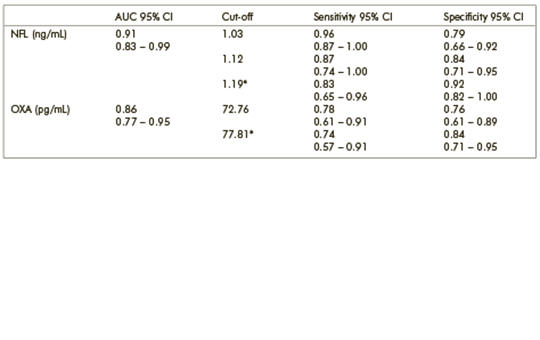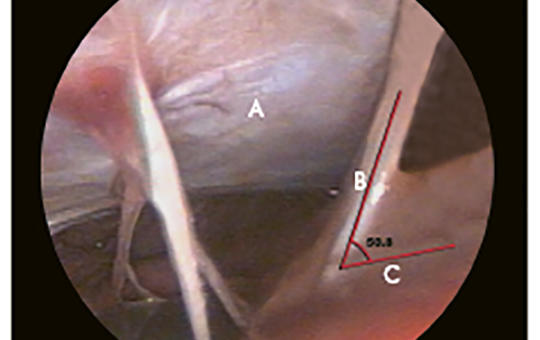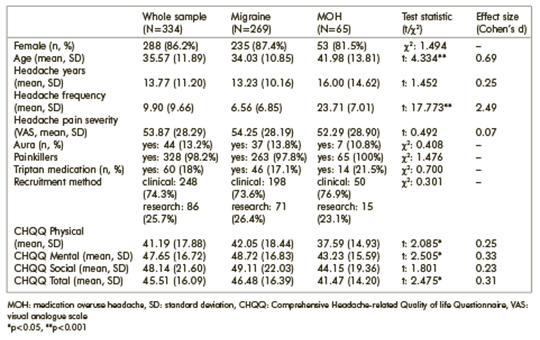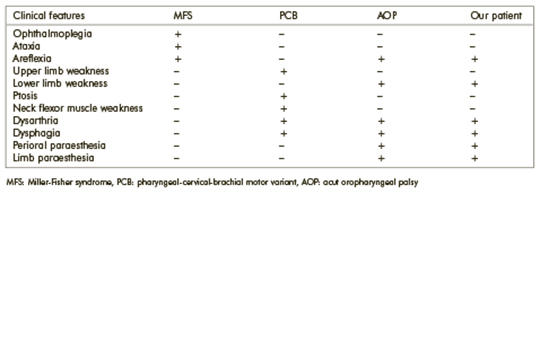The eLitMed.hu medical portal uses computer cookies for convenient operation. Detailed information can be found in the Cookie-policy.
Clinical Neuroscience - 2022;75(07-08)
Content
Comparison of orexin-A and neurofilament light chain levels in patients with relapsing-remitting multiple sclerosis: a pilot study
Multiple sclerosis is an autoimmune disease of the central nervous system, with myelin degeneration and Relapsing-Remitting Multiple Sclerosis (RRMS) as the most common type. The aim of this study was to determine the levels of Neurofilament Light Chain (NFL) and Orexin-A (OXA) in patients with RRMS and compare it with healthy control subjects’ data. In this case-control study of 61 subjects, serum and cerebrospinal fluid samples were collected from 23 RRMS patients and 38 healthy control subjects. NFL and OXA levels were determined in cerebrospinal fluid and serum samples using enzyme-linked immunosorbent assay kits. Self-reported questionnaires were also administered to evaluate fatigue severity and impact. Receiver operating characteristic curve analysis was used to determine the optimal cut-off value of NFL and OXA. The NFL and OXA concentrations in cerebrospinal fluid of RRMS patients were significantly higher than those of the control group (p < 0.001), but no significant difference was found in the serum concentrations (p = 0.842, p = 0.597, respectively). The cut-off values were found to be 1.194 ng/ml for NFL and 77.81 pg/ml for OXA in cerebrospinal fluid. A positive correlation was found between the Expanded Disability Status Scale and Epworth Sleepiness Scale in RRMS patients (ρ = 0.49, p = 0.045). These results suggest that increased levels of both NFL and OXA in cerebrospinal fluid reflect neuronal destruction in RRMS. Further research of neurodegeneration should focus on neuropeptides to determine the possible roles in RRMS pathogenesis.
Early and late predictors of postoperative neurocognitive dysfunction in cardiac surgery
Postoperative cognitive dysfunction (POCD) is a multifactorial image characterized by insufficiency in features such as the ability to perform tasks requiring high brain functions. Cognitive dysfunction such as memory loss and decreased concentration, confusion, and delirium are common conditions in some patients in the early period after major surgical interventions such as cardiac surgery. POCD causes delays in postoperative recovery, long return-to-work times, and decreased quality of life. This study aims to demonstrate POCD in early and late stages in patients undergoing cardiac surgery through the Montreal Cognitive Assessment (MoCA) and the Mini Mental Test (MMT). In addition, we aim to determine predictive factors with these neurocognitive tests. MMT and MoCA tests were applied to the patients included in the study before cardiac surgery, on the sixth postoperative day and third month. Neurocognitive dysfunction detected on the sixth postoperative day was accepted as an early period, its detection in the postoperative third month was accepted as a late period. 127 patients without neurocognitive dysfunction in the preoperative period were included in the study. For early neurocognitive impairment, age, mean platelet volume (MPV), New York Heart Association (NYHA) classification, x-clamp time, cardio-pulmonary bypass (CPB) time, postoperative intensive care and hospital stay duration, and an event of acute myocardial infarction (AMI) in the preoperative period were determined as predictive factors. In addition, in late-period of neurocognitive dysfunction age, MPV, NYHA classification, x-clamp duration, CPB time, postoperative intensive care and hospital stay duration were shown as predictors of neurocognitive dysfunction. The results of our study support the literature findings showing that delirium is associated with a decline in cognitive functions three months after cardiac surgery. As a result, the lack of agreed diagnostic tests in the definition of POCD makes it difficult to standardize and interpret the research in this area. Therefore, a consensus to be reached in the diagnosis of POCD will ensure the use and correct interpretation of neurophysiological tests. In our study, advanced age and long hospital and intensive care stays were shown as predictive factors for both early and late neurocognitive dysfunctions. Furthermore, smoking was shown as a predictive factor only for late neurocognitive dysfunction.
An endoscope-assisted craniometric cadaveric study for the brain stem and the cisternal segment of the trochlear nerve
This study analyzed the relationship of trochlear nerve with neurovascular structures using craniometric measurements. The study was aimed to understand the course of trochlear nerve and minimize the risk of injury during surgical procedures. Twenty trochlear nerves of 10 fresh cadavers were studied bilaterally using endoscopic assistance through the view afforded by the lateral infratentorial-supracerebellar, and the combined presigmoid-subtemporal transtentorial approaches. Trochlear nerves were exposed bilaterally taking seven parameters into consideration: the distance between the cisternal segment of trochlear nerve and vascular structures (superior cerebellar artery/SCA; posterior cerebral artery/PCA), the origin of the trochlear nerve in the brain stem, the angle in the level of tentorial junction, length, diameter, and length of nerve in the cisternal segment. We identified the brain stem and cisternal segments of the trochlear nerve. The lateral infratentorial supracerebellar approach allowed the exposure of the cisternal segments (crural and ambient cisterns), including the origin of the nerve in the brain stem. The combined presigmoid-subtemporal transtentorial approaches provided visualization of the cisternal segment of the nerve and the free edge of the tentorium. In this study, the mean length and width of the trochlear nerve in the cisternal segment were 30.3 and 0.74 mm, respectively. Length of the trochlear nerve from its origin to its dural entrance was 37.2 mm, tentorial dural entrance angle of the trochlear nerve and exit angle of the trochlear nerve from the brain stem were 127.0 degrees and 54 degrees, PCA to trochlear nerve in mid ambient cistern and SCA to trochlear nerve in mid ambient cistern were 7.3 mm and 6.8mm. Trochlear nerve is vulnerable to injury during the surgical procedures. Therefore, it is necessary to have a sufficient knowledge of the anatomy of cisternal segment and its relationship with adjacent neurovascular structures. The anatomical and craniometric data can be helpful in middle and posterior fossa surgery in minimizing the potential injury of the trochlear nerve.
Neonatal brachial plexus palsy – early diagnosis and treatment
The incidence of brachial plexus palsy (BPP) has decreased recently, but the individual’s quality of life is endangered. To provide better chances to BPP neonates and infants, the Department of Developmental Neurology worked out, introduced, and applied a complex early therapy, including nerve point stimulation. After diagnosing the severity of BPP, early intensive and complex therapy should be started. Approximately after a week or ten days following birth, the slightest form (neurapraxia) normalizes without any intervention, and signs of recovery can be detected around this period. The therapy includes the unipolar nerve point electro-stimulation and the regular application of those elementary sensorimotor patterns, which activate both extremities simultaneously. With the guideline worked out and applied in the Department of Developmental Neurology, full recovery can be achieved in 50% of the patients, and even in the most severe cases (nerve root lesion), functional upper limb usage can be detected with typically developing body-scheme. Immediately starting complex treatment based on early diagnosis alters the outcome of BPP, providing recovery in the majority of cases and enhancing the everyday arm function of those who only partially benefit from the early treatment.
A cross-sectional study on the quality of life in migraine and medication overuse headache in a Hungarian sample: understanding the effect of headache characteristics
Previous studies using generic and disease specific instruments showed that both migraine and medication overuse headache are associated with lower health-related quality of life (HRQoL). The aim of our study was to assess HRQoL differences in migraineurs and in patients with MOH and to examine how headache characteristics such as years with headache, aura symptoms, triptan use, headache pain severity and headache frequency are related to HRQoL. In this cross-sectional study 334 participants were examined (248 were recruited from a tertiary headache centre and 86 via advertisements). The Comprehensive Headache-related Quality of life Questionnaire (CHQQ) was used to measure the participants’ HRQoL. Data showed normal distribution, therefore beside Chi-squared test parametric tests (e.g. independent samples t-test) were used with a two-tailed p<0.05 threshold. Linear regression models were used to determine the independent effects of sex, age, recruitment method, headache type (migraine vs. MOH) and headache characteristics (presence of aura symptoms, years with headache, headache pain severity, headache frequency and triptan use) separately for each domain and for the total score of CHQQ. Significance threshold was adopted to p0.0125 (0.05/4) to correct for multiple testing and avoid Type I error. Independent samples t-tests showed that patients with MOH had significantly lower scores on all CHQQ domains than migraineurs, except on the social subscale. Results of a series of regression analyses showed that triptan use was inversely related to all the domains of HRQoL after correction for multiple testing (p<0.0125). In addition, headache pain severity was associated with lower physical (p=0.001) and total scores (p=0.002) on CHQQ subscales. Based on the results, different headache characteristics (but not the headache type, namely migraine or MOH) were associated with lower levels of HRQoL in patients with headache. Determining which factors play significant role in the deterioration of HRQoL is important to adequately manage different patient populations and to guide public health policies regarding health service utilization and health-care costs.
[Telecare in Parkinson’s disease: A nationwide survey among Hungarian neurologists ]
[COVID-19 has made providing in-person care difficult. In most countries, including Hungary, telemedicine has partly served as a resolution for this issue. Our purpose was to explore the effects of COVID-19 on neurological care, the knowledge of neurology specialists on telemedicine, and the present state of telecare in Hungary, with a special focus on Parkinson’s disease (PD). Between July and October 2021, a nationwide online survey was conducted among actively practicing Hungarian neurology specialists who were managing patients with PD. A total of 104 neurologists were surveyed. All levels of care were evaluated in both publicly funded and private healthcare. Both time weekly spent on outpatient specialty consultation and the number of patients with PD seen weekly significantly decreased in public healthcare, while remained almost unchanged in private care (p<0.001); higher portion of patients were able to receive in-person care in private care (78.8% vs. 90.8%, p<0.001). In telecare, prescribing medicines has already been performed by the most (n=103, 99%). Electronic messages were the most widely known telemedicine tools (n=98, 94.2%), while phone call has already been used by most neurologists (n=95, 91.3%). Video-based consultation has been more widely used in private than public care (30.1% vs. 15.5%, p=0.001). Teleprocedures were considered most suitable for monitoring progression and symptoms of Parkinson’s disease and evaluating the need for adjustments to antiparkinsonian pharmacotherapy. COVID-19 has had a major impact on the care of patients with PD in Hungary. Telemedicine has mitigated these detrimental effects; however, further developments could make it an even more reliable component of care.]
A case study of acute oropharyngeal palsy concomitant with diabetic ketoacidosis
Acute oropharyngeal palsy is a rare variant of Guillain-Barré syndrome. In our study we present the case of a 63-year-old man with general symptoms who was diagnosed with diabetic ketoacidosis and prescribed insulin therapy. Two weeks later, the patient complained of paraesthesia of the perioral region and the tip of the tongue, dysphagia, and dysarthria. These symptoms were initially thought to be complications of the patient’s type-1 diabetes. Due to rapidly developing paraparesis, the patient became bedridden. Clinical symptoms, cerebrospinal fluid analysis and a nerve conduction study resulted in a diagnosis of acute oropharyngeal palsy, a variant of Guillain-Barré syndrome. After five consecutive days of intravenous immunoglobulin treatment, neurological symptoms improved and the need for insulin ceased. One year later, the patient’s only remaining neurological symptom was loss of tendon reflexes in the lower extremities. Furthermore, the patient’s blood glucose level was normal without the use of medications or a special diet. Here, we report that oropharyngeal palsy can co-occur with diabetic ketoacidosis, and that immuntherapy is effective in treating both oropharyngeal palsy and type-1 diabetes. To our knowledge, this is the first description of a patient presenting with acut oropharyngeal palsy concomitant with diabetic ketoacidosis.
[The peak latency prolongation of the blink reflex in a patient with trigeminal neuralgia of Meckel’s cave mass ]
[The blink reflex test of the trigeminal nerve can provide valuable information about lesions site. However it may not find small compressive lesions. We observed peak latency prolongation of the blink reflex test in a patient with trigeminal neuralgia caused by a small Meckel’s cave mass, in whom the onset latency was normal. Conclusion – We suggest peak latency of the blink reflex might be a valuable aid for discerning small mass in patients with trigeminal neuralgia. This is the first case report of compressive trigeminal neuralgia showing peak latency prolongation of the blink reflex test.]
[COVID-19 with strange hallucinations and focal EEG abnormalities: Two case reports]
[Scientific literature about the ongoing COVID-19 disease and pandemic is considerable, though articles concentrate on the severe cases and their central nervous system manifestations. This article demonstrates two cases: middle-aged female patients who had serologically proven SARS-CoV-2 infection with mild upper airway and central nervous system symptoms. The patients reported vivid, strange, simple, and complex visual and auditory hallucinations. A characteristic element of these complex hallucinations was a talking human-shaped figure. Only three similar cases have been published; this article discusses common features of all five patients. This summary highlights that in COVID-19 cases, minor central nervous system symptoms can accompany mild or even missing upper respiratory symptoms. The cranial MRIs of the presented patients were normal, but the EEG showed focal abnormalities in localizations related to hallucinations, which emphasizes the importance of EEG in differential diagnostic procedures. ]
1.
Clinical Neuroscience
Is there any difference in mortality rates of atrial fibrillation detected before or after ischemic stroke?2.
Clinical Neuroscience
Factors influencing the level of stigma in Parkinson’s disease in western Turkey3.
Clinical Neuroscience
Neuropathic pain and mood disorders in earthquake survivors with peripheral nerve injuries4.
Journal of Nursing Theory and Practice
[Correlations of Sarcopenia, Frailty, Falls and Social Isolation – A Literature Review in the Light of Swedish Statistics]5.
Clinical Neuroscience
[Comparison of pain intensity measurements among patients with low-back pain]1.
2.
Clinical Neuroscience Proceedings
[A Magyar Stroke Társaság XVIII. Kongresszusa és a Magyar Neuroszonológiai Társaság XV. Konferenciája. Absztraktfüzet]3.
4.
Journal of Nursing Theory and Practice
[A selection of the entries submitted to the literary contest "Honorable mission: the joys and challenges of our profession" ]5.
Journal of Nursing Theory and Practice
[End of Life and Palliative Care of Newborns in the Nursing Context]











